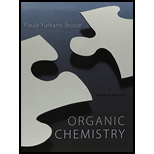
Concept explainers
a)
Interpretation:
The structure of phenyl acetate has to be drawn.
Concept Introduction:
Nomenclature of carboxylate (ester): Carboxylate (deprotonated form of carboxylic acid) is named by replacing the terminal ‘oic acid’ of the name with ‘oate’. In common nomenclature, the position of a substituent is designated by a lowercase Greek letter, and the carbonyl carbon is not given a designation. Thus, the carbon adjacent to the carbonyl carbon is the alpha-carbon, the carbon adjacent to the alpha-carbon is the beta-carbon, and so on.

b)
Interpretation:
The structure of
Concept Introduction:
Nomenclature of Lactam: Cyclic amides are called lactam. In systematic name, ‘2-azacycloalkanones’ (‘aza’- indicates the nitrogen atom). For, common name, the length of the carbon chain is indicated by the common name of the carboxylic acid, and a Greek letter specifies the carbon to which the nitrogen is attached. 6-membered ring lactams are

c)
Interpretation:
The structure of N-benzylethanamide has to be drawn.
Concept Introduction:
Nomenclature of Amides: Amides are named by replacing ‘oic acid’, ‘ic’ acid, or ‘ylic’ acid of the acid name with ‘amide’. If a substituent is bonded to the nitrogen, the name of the substituent is stated first (if more, stated in alphabetical order) followed by the name of the amide. The name of each substituent is preceded by N to indicate that the substituent is bonded to a nitrogen.

d)
Interpretation:
The structure of
Concept Introduction:
Nomenclature of carboxylic acid: Carboxylic acid is named by replacing the terminal ‘e’ of the
Carboxylic acids in which a carboxyl group is attached to a ring are named by adding ‘carboxylic acid’ to the name of the cyclic compound.

e)
Interpretation:
The structure of ethyl 2-chloropentanoate has to be drawn.
Concept Introduction:
Nomenclature of carboxylate (ester): Carboxylate (deprotonated form of carboxylic acid) is named by replacing the terminal ‘oic acid’ of the name with ‘oate’. In common nomenclature, the position of a substituent is designated by a lowercase Greek letter, and the carbonyl carbon is not given a designation. Thus, the carbon adjacent to the carbonyl carbon is the alpha-carbon, the carbon adjacent to the alpha-carbon is the beta-carbon, and so on.

f)
Interpretation:
The structure of
Concept Introduction:
Nomenclature of Amides: Amides are named by replacing ‘oic acid’, ‘ic’ acid, or ‘ylic’ acid of the acid name with ‘amide’. If a substituent is bonded to the nitrogen, the name of the substituent is stated first (if more, stated in alphabetical order) followed by the name of the amide. The name of each substituent is preceded by a N to indicate that the substituent is bonded to a nitrogen.

g)
Interpretation:
The structure of cyclohexanecarbonyl chloride has to be drawn.
Concept Introduction:
Nomenclature of Acyl chlorides: Acyl chlorides are named by replacing ‘ic acid’ of the acid name with ‘yl chloride’. For cyclic acids, that end with ‘carboxylic acid’ is replaced with ‘carbonyl chloride’.

h)
Interpretation:
The structure of
Concept Introduction:
Nomenclature of carboxylic acid: Carboxylic acid is named by replacing the terminal ‘e’ of the alkane or alkene name with ‘oic acid’. In common nomenclature, the position of a substituent is designated by a lowercase Greek letter, and the carbonyl carbon is not given a designation. Thus, the carbon adjacent to the carbonyl carbon is the alpha-carbon, the carbon adjacent to the alpha-carbon is the beta-carbon, and so on.
Carboxylic acids in which a carboxyl group is attached to a ring are named by adding ‘carboxylic acid’ to the name of the cyclic compound.

Want to see the full answer?
Check out a sample textbook solution
Chapter 16 Solutions
Organic Chemistry-With Access and Study Guide / Solutions Manual
 ChemistryChemistryISBN:9781305957404Author:Steven S. Zumdahl, Susan A. Zumdahl, Donald J. DeCostePublisher:Cengage Learning
ChemistryChemistryISBN:9781305957404Author:Steven S. Zumdahl, Susan A. Zumdahl, Donald J. DeCostePublisher:Cengage Learning ChemistryChemistryISBN:9781259911156Author:Raymond Chang Dr., Jason Overby ProfessorPublisher:McGraw-Hill Education
ChemistryChemistryISBN:9781259911156Author:Raymond Chang Dr., Jason Overby ProfessorPublisher:McGraw-Hill Education Principles of Instrumental AnalysisChemistryISBN:9781305577213Author:Douglas A. Skoog, F. James Holler, Stanley R. CrouchPublisher:Cengage Learning
Principles of Instrumental AnalysisChemistryISBN:9781305577213Author:Douglas A. Skoog, F. James Holler, Stanley R. CrouchPublisher:Cengage Learning Organic ChemistryChemistryISBN:9780078021558Author:Janice Gorzynski Smith Dr.Publisher:McGraw-Hill Education
Organic ChemistryChemistryISBN:9780078021558Author:Janice Gorzynski Smith Dr.Publisher:McGraw-Hill Education Chemistry: Principles and ReactionsChemistryISBN:9781305079373Author:William L. Masterton, Cecile N. HurleyPublisher:Cengage Learning
Chemistry: Principles and ReactionsChemistryISBN:9781305079373Author:William L. Masterton, Cecile N. HurleyPublisher:Cengage Learning Elementary Principles of Chemical Processes, Bind...ChemistryISBN:9781118431221Author:Richard M. Felder, Ronald W. Rousseau, Lisa G. BullardPublisher:WILEY
Elementary Principles of Chemical Processes, Bind...ChemistryISBN:9781118431221Author:Richard M. Felder, Ronald W. Rousseau, Lisa G. BullardPublisher:WILEY





